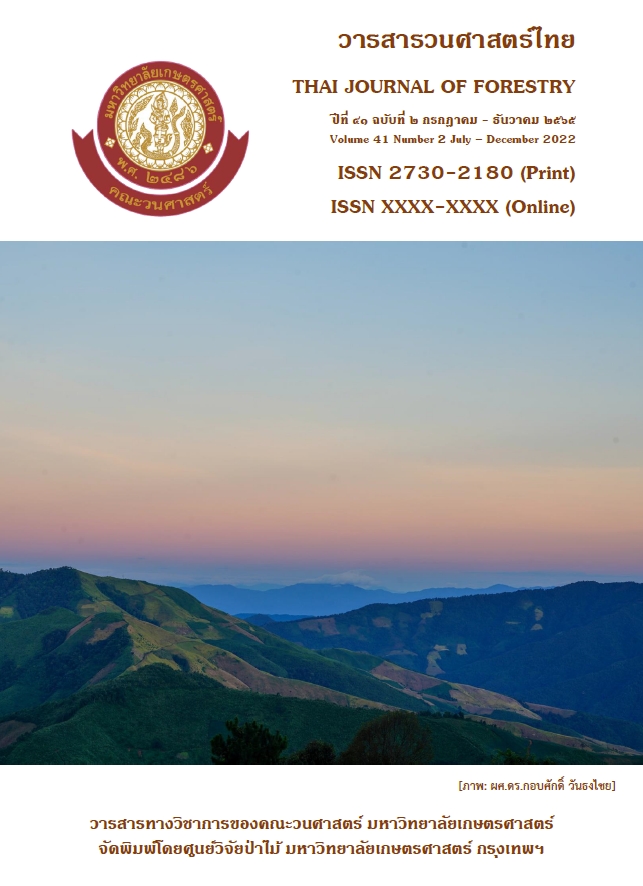บทบาทของพืชพื้นบ้านต่อวิถีชีวิตของชุมชนท้องถิ่นรอบกลุ่มป่าดงพญาเย็น – เขาใหญ่
Main Article Content
บทคัดย่อ
การวิจัยนี้มีวัตถุประสงค์เพื่อสำรวจชนิดพืชพื้นบ้านที่มีการใช้ประโยชน์ของชุมชน และพืชพื้นบ้านมีความสำคัญอย่างไรกับชุมชนรอบกลุ่มป่าดงพญาเย็น-เขาใหญ่ เพื่อให้ทราบถึงบทบาทของชุมชนในการจัดการทรัพยากรท้องถิ่น พร้อมกับเป็นแนวทางส่งเสริมการใช้ประโยชน์จากพืชพื้นบ้านอย่างยั่งยืน โดยดำเนินการในปี พ.ศ. 2562–2564 ด้วยวิธีการเดินสำรวจชนิดพืชพื้นบ้านในพื้นที่ชุมชนและป่าธรรมชาติ และวิธีการสัมภาษณ์แบบเจาะลึกกับผู้ให้ข้อมูลหลัก ผลการวิจัยพบว่าชุมชนได้ใช้ประโยชน์พืชพื้นบ้านจำนวน 467 ชนิด ใน 106 วงศ์ มีการใช้ประโยชน์จากชนิดพืชมากที่สุด 3 ลำดับแรก คือ อาหาร ร้อยละ 55.5 พืชสมุนไพร ร้อยละ 29.3 จำหน่าย ร้อยละ 20.3 โดยพื้นที่ของชุมชนเป็นแหล่งที่รวบรวมชนิดพืชพื้นบ้านไว้มากที่สุด ร้อยละ 83.9 พื้นที่ป่าธรรมชาติ ร้อยละ 35.3 โดยมีพืชที่พบทั้งสองแหล่ง ร้อยละ 19.7 สำหรับบทบาทของพืชพื้นบ้านต่อวิถีชีวิตของชุมชนสามารถสรุปได้ 4 ประการ ได้แก่ การตอบสนองต่อปัจจัยพื้นฐานในการดำรงชีวิต เป็นส่วนหนึ่งของวัฒนธรรมชุมชน มีส่วนสำคัญในการสร้างเศรษฐกิจที่ยั่งยืน และเป็นแหล่งความรู้และการอนุรักษ์พันธุ์พืช
คำสำคัญ: พืชพื้นบ้าน วิถีชีวิต ชุมชนท้องถิ่น กลุ่มป่าดงพญาเย็น - เขาใหญ่
Downloads
Article Details

อนุญาตภายใต้เงื่อนไข Creative Commons Attribution-NonCommercial-NoDerivatives 4.0 International License.
ข้าพเจ้าและผู้เขียนร่วม (ถ้ามี) ขอรับรองว่า ต้นฉบับที่เสนอมานี้ยังไม่เคยได้รับการตีพิมพ์และไม่ได้อยู่ในระหว่างกระบวนการพิจารณาตีพิมพ์ลงในวารสารหรือสิ่งตีพิมพ์อื่นใด ข้าพเจ้าและผู้เขียนร่วม (ถ้ามี) ยอมรับหลักเกณฑ์และเงื่อนไขการพิจารณาต้นฉบับ ทั้งยินยอมให้กองบรรณาธิการมีสิทธิ์พิจารณาและตรวจแก้ต้นฉบับได้ตามที่เห็นสมควร พร้อมนี้ขอมอบลิขสิทธิ์ผลงานที่ได้รับการตีพิมพ์ให้แก่วารสารวนศาสตร์ คณะวนศาสตร์ มหาวิทยาลัยเกษตรศาสตร์ กรณีมีการฟ้องร้องเรื่องการละเมิดลิขสิทธิ์เกี่ยวกับภาพ กราฟ ข้อความส่วนใดส่วนหนึ่ง หรือ ข้อคิดเห็นที่ปรากฏในผลงาน ให้เป็นความรับผิดชอบของข้าพเจ้าและผู้เขียนร่วม (ถ้ามี) แต่เพียงฝ่ายเดียว และหากข้าพเจ้าและผู้เขียนร่วม (ถ้ามี) ประสงค์ถอนบทความในระหว่างกระบวนการพิจารณาของทางวารสาร ข้าพเจ้าและผู้เขียนร่วม (ถ้ามี) ยินดีรับผิดชอบค่าใช้จ่ายทั้งหมดที่เกิดขึ้นในกระบวนการพิจารณาบทความนั้น”
เอกสารอ้างอิง
Brown, J., Hay-Edie, T. 2014. Engaging Local Communities in Stewardship of World Heritage: A Methodology Based on the COMPACT Experience. UNESCO, Paris.
Chamaratana, T. 2008. The Logic of Social Research. Available Source: http://www.kroobannok.com/blog/3293, 20 Apirl 2021. (in Thai)
Jarusombat, S., Phonok, N., Ruangsuwan, C. 2019. Green Economic Path. Policy Research Center on Green Economy, Faculty of Economics, Thammasat University, Bangkok. (in Thai)
Khawtong, M., Leknoi, A. 2021. Lesson learned of driving a low-carbon agricultural community under the concept of new theory agriculture: case study of Khlong Noi district, mueang district, Suratthani province. Journal of MCU Nakhondhat, 8(7): 390–404. (in Thai)
Office of the Forest Herbarium. 2014. Tem Smitinand’s Thai Plant Names, Revised Edition 2014. Office of the Forest Herbarium, Department of National Parks, Wildlife and Plant Conservation, Bangkok. (in Thai)
Podhisita, C. 2013. The Science and Art of Qualitative Research. (6th). Amarin Printing & Publishing Public Company Limited, Bangkok. (in thai)
Secretariat of the Convention on Biological Diversity. 2010. Forest Biodiversity-Earth’s Living Treasure. Montreal.
Suamuang, T., Munkratok, Y. 2018. Lessons learned from the development process of organic agriculture in Ban Khao Din, Khlong Hat district, Sa Kaeo province. Thai Journal of Pharmacy Practice, 10(1): 49 -59. (in Thai)
Thai World Heritage Information Centre. 2021. Dong Phayayen – Khao Yai Forest Complex. Ministry of Culture. Available Source: http://164.115.22.96/heritage_nature2.aspx#a5, 28 Apirl 2021. (in Thai)
Theerasasawat, S. 2003. Isan Village Economy: Economic History of Isan after World War II to the Present (1945-2001). Thailand Science Research and Innovation, Bangkok. (in Thai)


